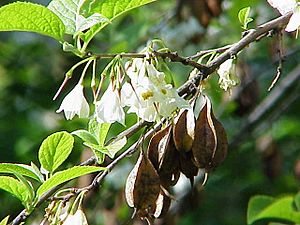Silverbell facts for kids
Quick facts for kids Silverbell |
|
|---|---|
 |
|
| Halesia carolina | |
| Scientific classification |
|
| Kingdom: | Plantae |
| Clade: | Tracheophytes |
| Clade: | Angiosperms |
| Clade: | Eudicots |
| Clade: | Asterids |
| Order: | Ericales |
| Family: | Styracaceae |
| Genus: | Halesia J.Ellis ex L. |
| Species | |
|
See text |
|
Halesia, also known as silverbell or snowdrop tree, is a small group of four or five types of trees or large shrubs. These plants lose their leaves every year. They belong to the plant family called Styracaceae.
Contents
Where Silverbell Trees Grow
Silverbell trees are found naturally in two main areas. One area is eastern Asia, specifically in southeast China. The other area is eastern North America. In North America, they grow from southern Ontario, Canada, all the way south through Florida and eastern Texas in the United States.
What Silverbell Trees Look Like
These trees usually grow to be about 5 to 20 meters (16 to 66 feet) tall. Sometimes, they can even reach 39 meters (128 feet)!
Their leaves are simple and oval-shaped. They are about 5 to 16 centimeters (2 to 6 inches) long and 3 to 8 centimeters (1 to 3 inches) wide. The leaves grow in an alternating pattern along the branch.
The flowers are a beautiful feature of these trees. They hang down and are usually white or light pink. They grow in small groups of 2 to 6 flowers. Each flower is about 1 to 3 centimeters (0.4 to 1.2 inches) long.
After the flowers, the tree produces a special kind of fruit. This fruit is dry and oblong, about 2 to 4 centimeters (0.8 to 1.6 inches) long. Most silverbell species have four narrow, wing-like ridges along their fruit. However, one type, Halesia diptera, only has two wings. This makes its fruit look quite different from the others.
Types of Silverbell Trees
There are several different types, or species, of silverbell trees:
- Halesia carolina: This is often called the little silverbell. It grows in eastern North America.
- Halesia diptera: Known as the two-wing silverbell, it grows in southeastern North America. Its fruit has only two wings.
- Halesia macgregorii: This is the Chinese silverbell or Macgregor's silverbell. It is found in eastern China.
- Halesia tetraptera: This is the common silverbell, also found in eastern North America.
- Halesia monticola: This type is called the mountain silverbell. It grows in the southern Appalachian Mountains. Some people think it's a separate species, while others consider it a variety of Halesia carolina.
Halesia monticola is the tallest type of silverbell tree. Some have been found to be 39 meters (128 feet) tall in the Great Smoky Mountains National Park in North Carolina. The Chinese silverbell, H. macgregorii, is the second tallest, reaching about 24 meters (79 feet). The other types usually don't grow taller than 10 meters (33 feet).
How Silverbell Trees Are Named
The way American silverbell species are named can be a bit confusing! Scientists have had many discussions about them.
One debate is about which specific tree Carl Linnaeus first named Halesia carolina. Some think it's the same as H. parviflora, while others believe it's the same as H. tetraptera.
Another discussion is whether H. monticola is different enough to be its own species. Or, should it be considered a variety of another silverbell? These questions are still being studied by botanists (plant scientists).
Recently, a study looked at the family tree of these plants. It suggested that the Chinese species, Halesia macgregorii, might be different enough to be put into a new group, or genus. This new genus was named Perkinsiodendron, after a botanist named Janet Russell Perkins.
The genus Halesia was named after Stephen Hales by John Ellis in 1759.
Ancient Silverbell Trees
Scientists have found a fossil of a silverbell fruit from a very long time ago. This fossil, named †Halesia crassa, was found in Denmark. It came from a layer of rock that is from the middle Miocene period. This shows that silverbell trees have been around for millions of years!
Growing and Using Silverbell Trees
Silverbell trees are very popular ornamental plants. People like to plant them in large gardens because of their beautiful, delicate flowers. These flowers hang down and appear in late spring, making the trees a lovely sight.
See also
 In Spanish: Halesia para niños
In Spanish: Halesia para niños

